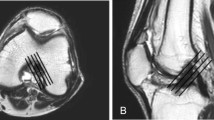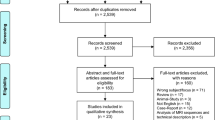Abstract
Objective
To determine the normal depth of the medial femoral sulcus on lateral radiographs of the knee and determine if abnormal deepening of the medial femoral sulcus exists as a radiographic indicator of intra-articular knee abnormalities.
Materials and methods
A retrospective search was performed over a period of 10 years to identify all individuals with a bone contusion of the anterior medial femoral condyle at MR imaging. Study patients had documented acute knee injuries and radiographs 6 weeks or less prior to their MR. A control group had normal MR exams and radiographs 6 weeks or less prior to their MR. Two fellowship-trained musculoskeletal radiologists independently measured the depth of the medial femoral sulcus on lateral radiographs blinded to control or study individuals.
Results
The study group consisted of 76 patients (57 men, 19 women; age range, 18–50 years; mean age, 27 years) and 92 control patients (33 men, 59 women; age range, 18–46 years; mean age 26 years). Sulcus depth was (0–2.3 mm reader 1 and 0–1.7 mm reader 2 for controls; 0–2.2 mm reader1 and 0–1.8 mm reader 2 for study patients). No significant difference in sulcus depth was identified between the control and study groups. Inter-reader agreement was very strong. The most common cause of injury in the study group was motor vehicle accidents followed by hyperextension and twisting injuries of the knee.
Conclusion
The normal medial femoral sulcus ranges in depth from 0 to 2.3 mm. Although impaction of the sulcus does occur following knee injuries, the sulcus does not deepen.




Similar content being viewed by others
References
Gottsegen CJ, Eyer BA, White EA, Learch TJ, Forrester D. Avulsion fractures of the knee: imaging findings and clinical significance. Radiographics. 2008;28(6):1755–70.
Cobby MJ, Schweitzer ME, Resnick D. The deep lateral femoral notch: an indirect sign of a torn anterior cruciate ligament. Radiology. 1992;184(3):855–8.
Sanders TG, Medynski MA, Feller JF, Lawhorn KW. Bone contusion patterns of the knee at MR imaging: footprint of the mechanism of injury. Radiographics. 2000 Oct;20.
Yu JS, Bosch E, Pathria MN, et al. Deep lateral femoral sulcus: study of 124 patients with anterior cruciate ligament tear. Emerg Radiol. 1995;2:129–34.
Lodewijks PCAM, Delawi D, Bollen TL, et al. The lateral femoral notch sign: a reliable diagnostic measurement in acute anterior cruciate ligament injury. Knee Surg Sports Traumatol Arthrosc. 2019;27:659–64.
Remer EM, Fitzgerald SW, Friedman H, et al. Anterior cruciate ligament injury: MR imaging diagnosis and patterns of injury. Radiographics. 1992;12(5):901–15.
Jae Ho Yoo, Eung Ha Kim, Soo Jae Yim, Byung III Lee. A case of compression fracture of medial tibial plateau and medial femoral condyle combined with posterior cruciate ligament and posterolateral corner injury. Knee. 2009. 83–86.
Marby L, Ross M, Abbott J Musculoskeletal imaging: impaction fracture of the medial femoral condyle. J Orthop Sports Phys Ther 2013;43(7):512.
Ali AM, Pillai JK, Gulati V, Gibbons CER, Roberton BJ. Hyperextension injuries of the knee: do patterns of bone bruising predict soft tissue injury? Skelet Radiol. 2018;47(2):173–9.
Resnick D. Diagnosis of bone and joint disorders. 4th ed. Philadelphia Pennsylvania: W.B. Saunders Company; 2002. p. 3167–8.
Akoglu H. User’s guide to correlation coefficients. Turk J Emerg Med. 2018;18(3):91–3.
Nakabayashi Y, Wevers HW, Cooke TD, Griffin MJ. Bone strength and histomorphometry of the distal femur. J Arthroplast. 1994;9(3):307–15.
Mandalia V, Fogg AJB, Chari R, Murray J, Beale A, Henson JHL. Bone bruising of the knee. Clin Radiol. 2005;60:627–36.
Rangger C, Kathrein A, Freund MC, Klestil T, Kreczy A. Bone bruise of the knee: histology and cryosections in 5 cases. Act Orthop Scand. 1998;69:291–4.
Sonin AH, Fitzgerald SW, Friedman H, et al. Posterior cruciate ligament injury: MR imaging diagnosis and patterns of injury. Radiology. 1994;190:455–8.
Yu JS, Goodwin D, Salonen D, et al. Complete dislocation of the knee: spectrum of associatedsoft-tissue injuries depicted by MR imaging. AJRAm J Roentgenol. 1995;164:135–9.
Bassett LW, Grover JS, Seeger LL. Magnetic resonance imaging of knee trauma. Skeletal Radiol 1990; 19:401–405.
Twaddle BC, Hunter JC, Chapman JR, Simoniah PT, Escobedo EM. MRI in acute knee dislocation: a prospective study of clinical, MRI, and surgical findings. J Bone Joint Surg Br. 1996;78:573–9.
Ringler MD, Shotts EE, Collins MS, Howe BM. Intraarticular pathology associated with isolated posterior cruciate ligament injury on MRI. Skeletal Radiol. 2016;45(12):1695–703.
Calvo-Gurry M, Hurley ET, Withers D, Vioreanu M, Moran R. Posterior tibial bone bruising associated with posterior-medial meniscal tear in patients with acute anterior cruciate ligament injury. Knee Surg Sports Traumatol Arthrosc. 2019;27(11):3633–7.
Author information
Authors and Affiliations
Corresponding author
Ethics declarations
Conflict of interest
The authors declare that they have no conflict of interest.
Additional information
Publisher’s note
Springer Nature remains neutral with regard to jurisdictional claims in published maps and institutional affiliations.
Rights and permissions
About this article
Cite this article
Wissman, R.D., Stensby, D., Koolwal, J. et al. The deep medial femoral sulcus sign: does it exist?. Skeletal Radiol 50, 571–578 (2021). https://doi.org/10.1007/s00256-020-03600-y
Received:
Revised:
Accepted:
Published:
Issue Date:
DOI: https://doi.org/10.1007/s00256-020-03600-y




